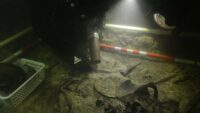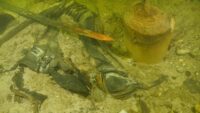 Underwater archaeologists have discovered the remains of a 16th century man and his kit at the bottom of Lake Asvejas in eastern Lithuania. The skeletal remains were found at a depth of 30 feet near Dubingiai Bridge, one of the longest wooden bridges still in use in Lithuania. Marine archaeologists uncovered bones, an iron sword, two knives with wooden handles and a spur. The armaments suggest the individual was a soldier. It is the first discovery of its kind in Lithuania.
Underwater archaeologists have discovered the remains of a 16th century man and his kit at the bottom of Lake Asvejas in eastern Lithuania. The skeletal remains were found at a depth of 30 feet near Dubingiai Bridge, one of the longest wooden bridges still in use in Lithuania. Marine archaeologists uncovered bones, an iron sword, two knives with wooden handles and a spur. The armaments suggest the individual was a soldier. It is the first discovery of its kind in Lithuania.
This was not a burial. No evidence has been found yet indicating how he died, but whatever caused his demise, his body sank to the bottom of the lake. All of the bones were found in situ. Protected by a layer of clay and sand sediment, some of the young man’s accessories also managed to survive– his leather boots and fragments of a thin leather belt.
 The lakebed was being surveyed before structural work replacing the bridge’s rotting wood beams with metal ones. Archaeologists and amateur divers worked together to survey the site. The remains were found during an inspection of the bridge’s supports.
The lakebed was being surveyed before structural work replacing the bridge’s rotting wood beams with metal ones. Archaeologists and amateur divers worked together to survey the site. The remains were found during an inspection of the bridge’s supports.
A previous survey in 1998 had revealed that another bridge once stood in the same place, dating to the 16th or 17th century — around the time that the medieval soldier died, [marine archaeologist Elena] Pranckėnaitė added.
“For now, we assume that those discovered human remains could be linked with the former bridge leading to Dubingiai castle, which was situated on the hilltop on the shore of Asveja Lake,” she said.
The human remains have been recovered and now being studied at the Faculty of Medicine of Vilnius University. The archaeological material is being conserved and analyzed by experts at the National Museum of Lithuania.
Hope they can nail the date down in more detail.
Very disturbingly, he was found, according to the ‘Google Translate’ service, with a “leather vagina”. However, what originally had been referred to was his sword scabbard, and terms like makštìs or maksts, as in several other languages, do indeed leave room for interpretation.
Apart from his “vagina”, more information about the rest of the “kit” would be interesting, how old it is exactly, and if he was a local or possibly acting on behalf of one of the several players from abroad, e.g. Sweden, Germany, Poland or Russia. Were there inscriptions or other hints?
Is that a spur on the left-hand boot? If so, the soldier could be of higher rank than a line infantryman.